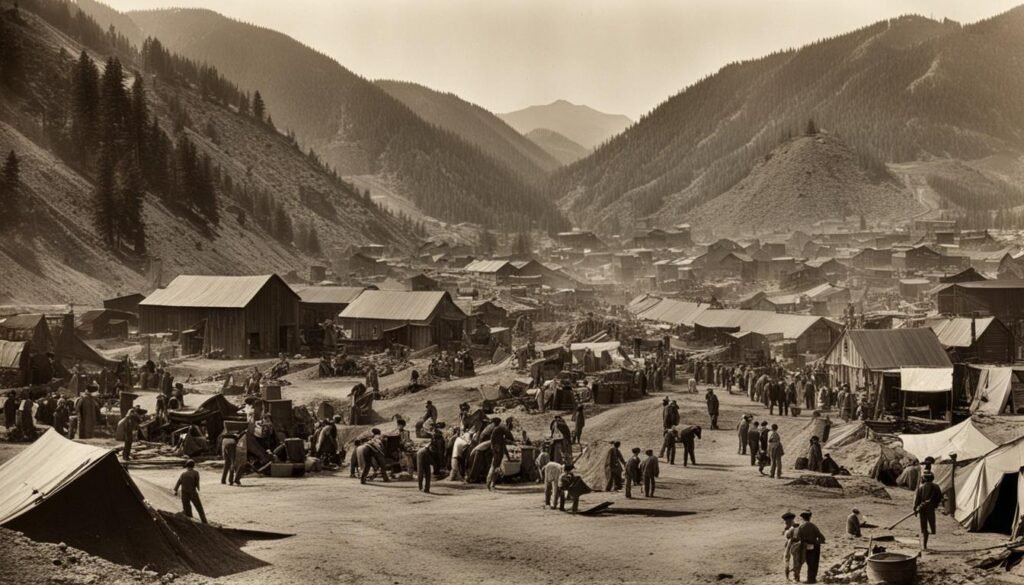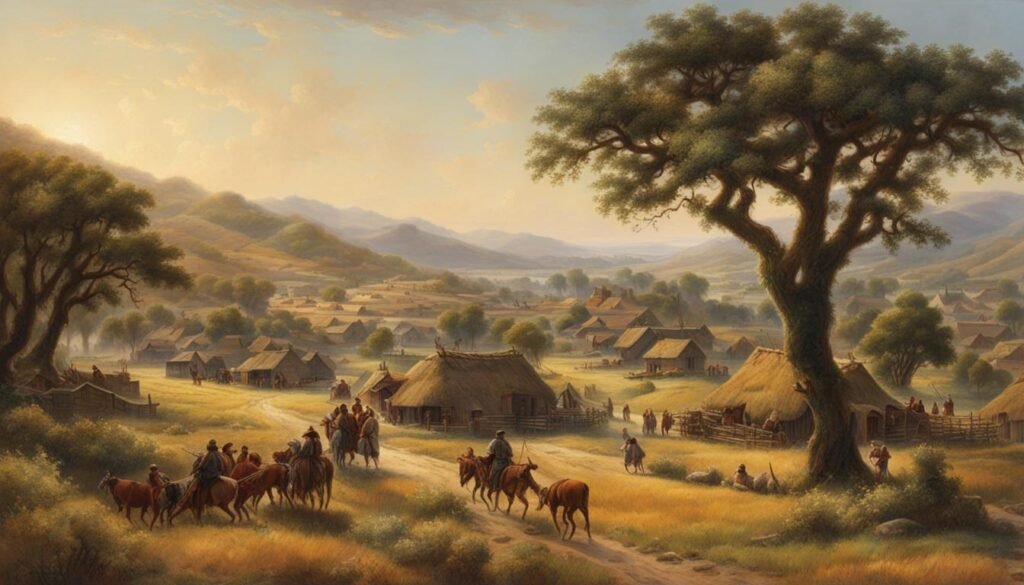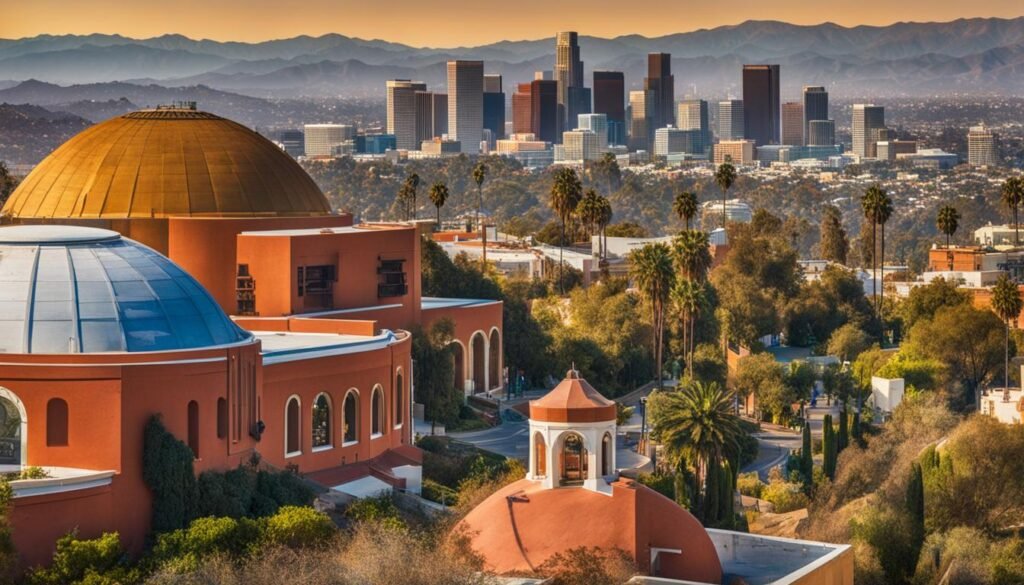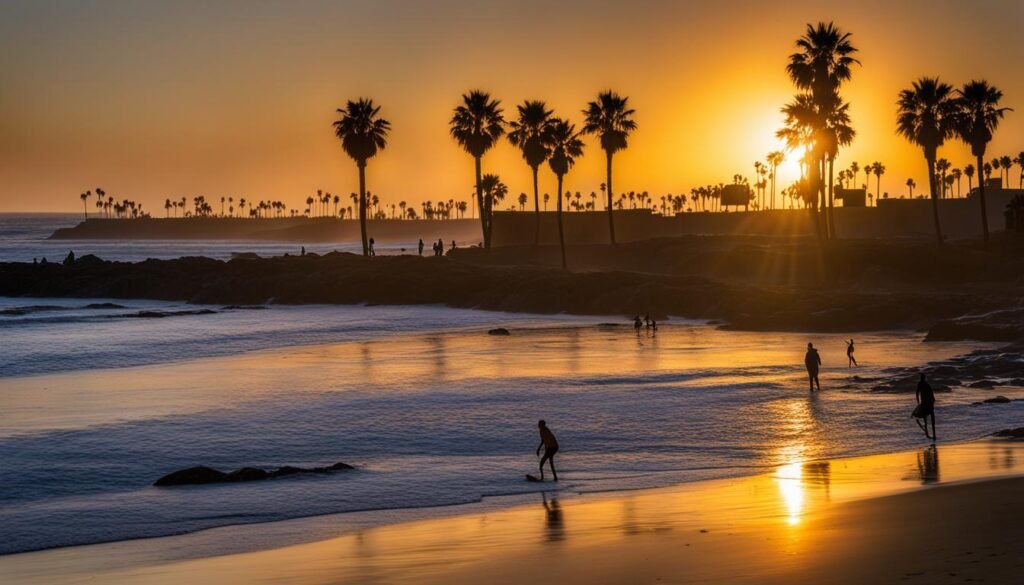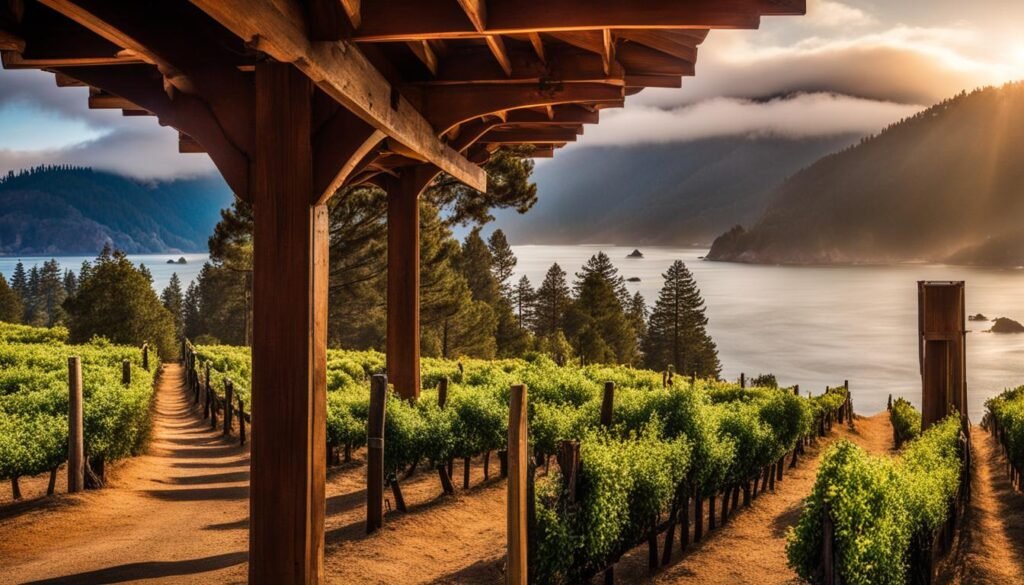Join me on a journey through the rich mission history of California, where the past comes alive amidst breathtaking architectural masterpieces and fascinating stories. From the first missions in California to the lasting impact of the mission system, we’ll delve into the captivating history that shaped the Golden State.
Starting in 1769, Spain embarked on a transformative endeavor, constructing a chain of 21 missions across Alta California. These missions not only served as religious institutions but also played a vital role in establishing Spanish presence and influence in the region.
The mission era in California lasted until 1834, leaving behind a lasting legacy. The distinct features of the missions, such as the iconic red tile roofs, whitewashed walls, arched colonnades, and bell towers, are still cherished and can be seen dotted throughout the state.
Stretching approximately 650 miles and situated just 30 miles apart, each mission offers a unique experience. Today, all 21 missions are open to visitors, providing a glimpse into the past through gift shops, museums, and even Sunday masses.
Let’s embark on this fascinating journey together, starting from the southern reaches of California and gradually making our way northward. Along the way, we’ll explore the captivating features and intriguing histories of each mission. From San Diego to San Francisco, remarkable tales await.
Key Takeaways:
- California’s mission system, established in 1769, played a crucial role in Spanish colonization and shaping the state’s heritage.
- The 21 missions, with their distinctive architectural features, remain a testament to California’s rich history.
- Visitors can explore these missions, which offer museums, gift shops, and the opportunity to attend mass.
- Each mission has its own unique characteristics and stories, making the exploration of all 21 a captivating adventure.
- From San Diego to San Francisco, the missions form a chain of cultural and historical treasures across the length of California.
Mission Basilica San Diego de Alcalá
When exploring the rich history of California’s missions, one cannot overlook the significance of Mission Basilica San Diego de Alcalá. Built in 1769 and fully restored in 1931, this mission holds a special place in the state’s heritage.
The mission stands tall with a striking 46-foot-tall tower, adorned with five magnificent bells that have rung for centuries. As you step onto the grounds, you’ll be greeted by picturesque bougainvillea-covered buildings and immaculate gardens, creating a serene and peaceful atmosphere.
Each day, the mission holds mass, offering visitors the opportunity to partake in the religious traditions that have echoed through centuries. For those seeking a deeper understanding of the mission’s history and architectural significance, guided tours are available upon advance request. These tours provide a comprehensive exploration of the mission’s structures, artwork, and the stories that have shaped its legacy.
Mission Basilica San Diego de Alcalá serves as a testament to the enduring spirit of California’s mission era. Its beauty and cultural significance make it a must-visit destination for history enthusiasts and those seeking a deeper connection to the state’s past.
Old Mission San Luis Rey de Francia
Known as the “King of the Missions,” Old Mission San Luis Rey de Francia is a captivating historical site that holds immense significance in California’s heritage. Set within a six-acre central square, this mission showcases remarkable architectural features and cultural artifacts that transport visitors back to the colonial era.


One of the standout features of Old Mission San Luis Rey de Francia is its impressive octagonal dome, which adds grandeur to the structure. As you wander through the mission’s meticulously maintained grounds, you’ll encounter various elements that truly capture the essence of the time.
- The lavandería, an open-air laundry area, provides a glimpse into the daily lives of the people who inhabited the mission.
- Tiled stairs lead to hidden corners and offer charming vistas of the surrounding landscape.
- Stone pools, once used for various purposes, now serve as serene focal points where visitors can pause and reflect.
- The mission’s intricately carved gargoyles showcase the exceptional craftsmanship that went into its construction.
Notably, Old Mission San Luis Rey de Francia is also home to the first pepper tree planted in California. This tree, dating back to 1830, stands as a living testament to the mission’s rich history and the agricultural practices of the time.
If you’re fascinated by California’s past and eager to immerse yourself in its historical tapestry, a visit to Old Mission San Luis Rey de Francia is a must. Explore the mission’s intriguing architecture, soak in the serene atmosphere, and gain a deep appreciation for the legacy left behind by those who once called this place home.
Mission San Juan Capistrano
Mission San Juan Capistrano is a historic landmark that holds a special place in California’s history. What sets this mission apart is its unique association with the annual return of the swallows, known as the “Swallows of Capistrano.”
Each year, thousands of cliff swallows migrate from Goya, Argentina, to Mission San Juan Capistrano, where they spend the spring and summer months. This incredible natural phenomenon has captivated visitors for generations.
The mission offers a variety of educational opportunities to learn more about the swallows and their annual pilgrimage. Visitors can explore interactive exhibits, watch informative documentaries, and even witness the famous “Blessing of the Swallows” ceremony.
Aside from the swallows, Mission San Juan Capistrano is also conveniently located near the historic Los Rios District, which is known as California’s oldest neighborhood. This charming district is lined with adobe buildings, quaint shops, local cafés, and beautiful gardens. Exploring the Los Rios District offers a delightful glimpse into the region’s rich cultural heritage.
San Gabriel Arcángel
San Gabriel Arcángel was an impressive mission located in the San Gabriel Valley. It stood as a fortress-like structure with a 170-acre vineyard, making it the largest vineyard in the entire mission chain. The mission’s historical and architectural significance cannot be overstated, as it holds a key place in California’s mission history.
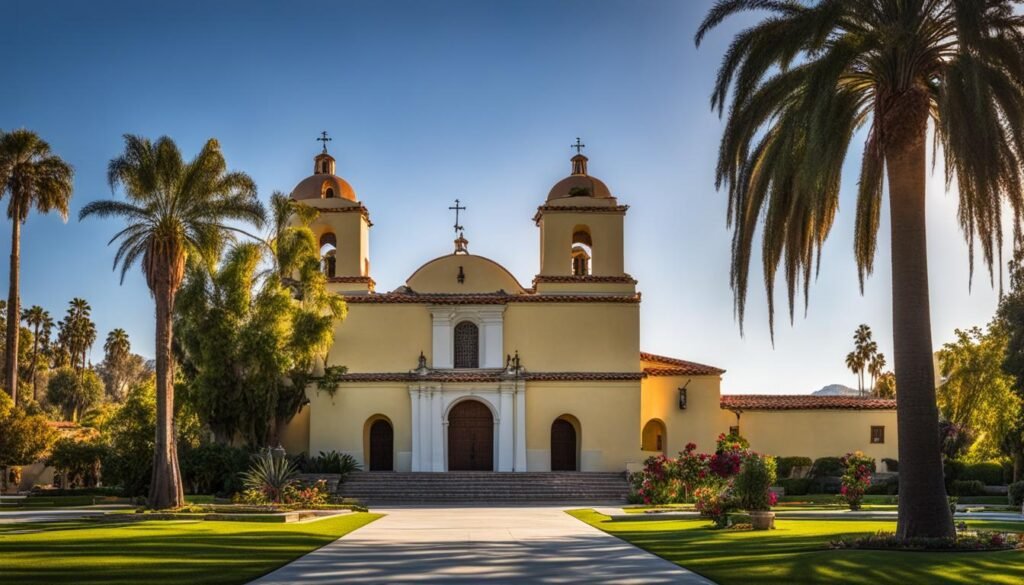

Key Features of San Gabriel Arcángel:
- An altar framed by a large round skylight, providing an awe-inspiring setting for religious ceremonies.
- A hand-hammered copper baptismal font, showcasing the intricate craftsmanship of this mission.
The mission’s vineyard played a pivotal role in sustaining the community and mission activities. With its expansive size, it played an essential part in the economic development of the area.
San Gabriel Arcángel stands as a testament to the rich history and cultural heritage of the region. Its architectural grandeur and storied past make it a must-visit destination for those interested in exploring California’s mission era.
Old Mission Santa Barbara
Old Mission Santa Barbara, also known as the “Queen of the Missions,” is a captivating testament to California’s rich history and architectural beauty. As the only California mission with twin bell towers, it stands out as a remarkable landmark.
Upon entering the mission grounds, visitors are greeted by a magnificent Moorish fountain, adding an air of tranquility to the surroundings. The sound of water gently cascading creates a soothing ambiance that transports you back in time.
An absolute highlight of Old Mission Santa Barbara is its breathtaking rose gardens. These vibrant and fragrant gardens are a sight to behold, showcasing a dazzling array of colors and delicate aromas that captivate the senses.
One of the most remarkable features of Old Mission Santa Barbara is its Chumash altar. This altar, adorned with abalone shells, is a testament to the rich cultural heritage of the indigenous Chumash people who played a significant role in the history of the mission and the region.
Old Mission Santa Barbara is not only a historical and architectural gem but also a functional part of the local community. The original aqueduct built by the Franciscan friars is still in use, providing water to the vibrant city of Santa Barbara.
As you explore the grounds and visit the mission’s museum, you’ll gain a deeper understanding of the cultural significance of Old Mission Santa Barbara and its impact on the region. The preserved artifacts, historical displays, and informative exhibits offer a window into the past, providing a glimpse into California’s colonial era.
A visit to Old Mission Santa Barbara is a must for history enthusiasts and those seeking a deeper connection with California’s fascinating past. Immerse yourself in the rich history, cultural heritage, and architectural marvels that make this mission a true gem of the Golden State.
Conclusion
The mission era in California has left a lasting impact on the state’s history, culture, and architecture. These missions were not only centers of religious education but also played a vital role in the lives of the native converts by providing them with protection and guidance. However, it is important to acknowledge the negative effects these missions had on Native Californian cultures, as they contributed to the loss of traditional customs and practices.
Today, the missions stand as historical landmarks that attract visitors from around the world. They serve as reminders of California’s colonial past and provide a glimpse into the significant role the missions played in shaping the state’s development. From the first mission in San Diego de Alcalá to the architectural marvels of San Gabriel Arcángel and Old Mission Santa Barbara, the mission chain tells a captivating story of California’s rich heritage.
The mission era in California is an integral part of the state’s history timeline. It marks the period of Spanish colonization and the establishment of these iconic institutions. While the missions have faced criticism for their impact on indigenous cultures, their legacy continues to be cherished and studied. By preserving these historical sites, we can ensure that future generations understand the complex history and its lasting implications.
FAQ
What is the mission system in California?
The mission system in California refers to the chain of 21 missions built by Spain across Alta California starting in 1769. These missions served as religious and educational centers, as well as providing protection to native converts. They played a significant role in California’s history, culture, and architecture.
What were the first missions in California?
The first mission in California was Mission Basilica San Diego de Alcalá, founded in 1769. It was followed by a total of 21 missions established throughout the length of Alta California.
What are some facts about the California missions?
The California missions were approximately 30 miles apart and covered a total of 650 miles. They feature iconic red tile roofs, whitewashed walls, arched colonnades, and bell towers. All 21 missions are open to visitors, with gift shops and museums, and most still hold mass on Sundays.
What unique features does Mission Basilica San Diego de Alcalá have?
Mission Basilica San Diego de Alcalá, built in 1769 and restored in 1931, features a 46-foot-tall tower with five bells. It has bougainvillea-covered buildings, immaculate gardens, and offers daily mass. Visitors can also request guided tours.
What makes Old Mission San Luis Rey de Francia special?
Old Mission San Luis Rey de Francia is known as the “King of the Missions.” It is set within a six-acre central square and features an octagonal dome. Highlights include a lavandería (open-air laundry), tiled stairs, stone pools, and carved gargoyles. It is also home to the first pepper tree planted in California in 1830.
Why is Mission San Juan Capistrano famous?
Mission San Juan Capistrano is famous for the annual return of migrating swallows, which spend most of the year in the mission before flying to Argentina for the winter. Visitors can learn more about the swallows and explore the historic Los Rios District, California’s oldest neighborhood, located nearby.
What sets San Gabriel Arcángel apart?
San Gabriel Arcángel was a fortress-like mission with a 170-acre vineyard, the largest in the mission chain. It features an altar framed by a large round skylight and a hand-hammered copper baptismal font. The mission holds significant historical and architectural importance.
What is unique about Old Mission Santa Barbara?
Old Mission Santa Barbara is the only California mission with twin bell towers. It showcases a magnificent Moorish fountain, rose gardens, and an abalone-encrusted Chumash altar from the 1790s. The original aqueduct is still in use by the city of Santa Barbara.
What is the impact of the California missions?
The California missions played a significant role in the state’s history, culture, and architecture. While they served as centers of religious education and instruction, the missions also had negative impacts on Native Californian cultures, leading to the loss of traditions and customs. Today, the missions stand as historical landmarks, attracting tourists from all over the world and preserving the legacy of California’s colonial past.


